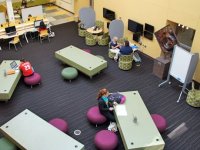Brain Labs: A Place to Enliven Learning
If your school had a student-friendly environment for teaching children about metacognition, children could develop their skills in self-reflection, paying attention, emotional regulation, and cognitive flexibility.
Your content has been saved!
Go to My Saved Content.Although emotion and cognition originate in different parts of the brain, they interact and play a powerful role in learning and memory. According to neuroscientists like Eric Jensen, priming the brain for particular states of engagement -- such as curiosity, intrigue, surprise, suspense, a bit of confusion, skepticism, and the feeling of safety -- prepares the mind to learn. Furthermore, incorporating emotion into our instruction and content supports long-term memory. This might not be news to teachers, but not enough students know how to optimize their brain for learning. That's why every child should have the opportunity to explore neuroscience in a brain lab.
What Is a Brain Lab? What Is Its Purpose?
Every school or classroom should have a student- and teacher-created brain lab with these goals:
- Enhancing learners' cognitive, emotional, and social well-being
- Teaching students how their brains work
- Supporting students as they explore their thinking and feelings about topics, relationships, and experiences
- Helping students regroup and refocus
- Improving academic achievement and standards
- Crossing disciplinary boundaries
Students could be assigned personal folders with choices of lab activities. Meanwhile, teachers might choose a brain topic each week or month, such as stress, memory, or exercise, movement, and the brain.
Using Pop Culture to Study the Brain
Some brain-related topics could take advantage of recent research and pop culture. For example, one module might include activities related to the ideas expressed by Pixar's film Inside Out in order to show how the brain processes thoughts, feelings, and experiences. The movie teaches a fundamental principle about the mind: We can control how our brain reacts to life's challenges. Students can learn to alleviate sadness, increase joy, or activate anger when necessary. Brain lab would be the space to explore how all emotions connect to students' lives and interests, as well as the academic curriculum.
Another key element of the brain lab curriculum would be the study of how students can adjust their thinking to positively reframe events originally perceived as negative. The understanding of neuroplasticity, defined as the brain's ability to change or adapt based upon experiences, can help students become better and smarter while learning about this important concept, as depicted in the Backwards Brain Bicycle. This short video demonstrates how neural pathways that are traveled frequently become hardwired into habits difficult to change without deliberation and effort. After viewing the video, students could share one undesirable habit that they will intentionally address during the year.
With those fundamental principles about neuroplasticity internalized, students could study new ways of memorizing and understanding information for a test, or ways to broaden their perspective about peers that were previously thought of as aggravating.
Social and Emotional Components of the Brain Lab
A welcoming brain lab that invites students to choose what they study can enhance their social-emotional learning skills. The lab can be a place where students refocus and become quiet. Children who quiet their minds and practice self-reflection boost development in the frontal lobes where the executive functions for paying attention, emotional regulation, and cognitive flexibility reside. This type of skill building can be aided by several resources:
- Instrumental music
- Comfortable seating
- Computers
- Headphones
- Stress balls
- Paper, colored pencils, and markers
- Books and magazines addressing social-emotional well-being through poetry, stories, or "how-to" genres
- Peppermints
A posted list of choices for enhancing brain development can be aligned with curriculum standards. For example, if students are learning factor trees in math, they could extend this task by using a similar protocol for creating a family ancestry tree. In order to teach inference making in language arts, instructors could bring a tattered house slipper or other worn object from home, show a video clip, or share a story without an ending. Learners could create an inference with a written or cartoon ending based upon the objects and videos presented.
Resources for the Brain Lab
Here are just a few of the documentaries, brain games, articles, reflection and perspective exercises, and many other resources that offer lessons on neuroanatomy:
- The Sentis Creative Showreel features animated brain videos.
- This edition of Edutopia's Five-Minute Film Festival teaches about learning and the brain.
- The Brain Bank at Harvard depicts interesting facets of neuroscience.
- Neuroscience for Kids features a newsletter and video presentation developed by Dr. Eric Chundler.
- National Geographic's Brain Games shows how to tap into imagination to solve problems.
- Edutopia's Social and Emotional Learning topic page contains resources for SEL skill building.
As we learn more about neuroscience and its relationship to teaching and learning, we can add more resources to the brain lab and help students take ownership of their brain development.
What would your brain lab look like?
